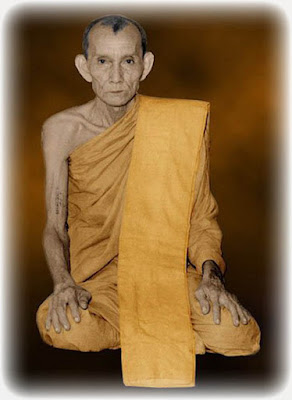Thai Amulets of LP Lee Wat Asokaram
LP Guay of Wat Kositaram
Luang Por Guay, a highly revered and accomplished Thai Buddhist monk, entered the monkhood on the 5th of June 2467 at 15:17 pm at the Uposadha shrine room of Wat Po Ngam in Sakburi, Chainat. His ordained name, 'Chudtintaro,' reflects the acknowledgment of the worldly turmoil, burdened by defilement and desire, and the aspiration to transcend these obstacles to reach the far shore of Nibbana.
Following his ordination, Luang Por Guay resided at Wat Kae under the guidance of Luang Phu Ma. His dedication to spiritual practice led him to delve into the recital of the Vessantara Jataka, Khantakumara, and Dhanakhanta, showcasing his unparalleled knowledge and mastery in these subjects. However, his unconventional preaching style, centered around the Vessantara Jataka, often evoked emotional responses, even leading some listeners to tears. Despite his unconventional approach, it became evident that Luang Por Guay possessed a unique understanding of magic.
In 2472, faced with an epidemic in Koke Chang village, Luang Por Guay turned to traditional medicine under the tutelage of Hmor Khian. Later, he embarked on the study of Bpariyadtitam (Theoretical Dhamma) at Wat Wang Khorn, eventually pursuing a Doctorate degree. His path took a turn when illness interrupted his academic pursuits, prompting him to focus on Vipassana Kammathana practice and Wicha Akom. He received training in crafting and empowering magical charms, amulets, effigies, and talismans.
His quest for knowledge led him to Wat Prang (Singhburi), where he learned the art of making magic rings from Luang Por Sri Wiriya Sopat. Notably, Luang Por Guay's magic rings bore the Khom Letters 'Idti,' a testament to his mastery. Further studies and magical training followed at Wat Nong Dta Gaew and Wat Nong Khaem, solidifying his reputation as a skilled practitioner.
One remarkable incident involved the discovery of an ancient 'Samut Khoi' grimoire. Through a ceremony and dedication of merits, Luang Por Guay secured the grimoire's permission to accompany him to the temple. The grimoire, containing hundreds of Yant and magic Kata, became a wellspring of powerful Wicha for Luang Por Guay.
Returning to Wat Ban Kae, Luang Por Guay became renowned for his Sak Yant tattoos. Local anecdotes spoke of individuals being shot at with no harm, attributing their protection to Luang Por Guay's tattoos. Despite the influx of devotees seeking Sak Yant, Luang Por Guay eventually retired from tattooing.
In 2491, he assumed the role of Abbot at Wat Ban Kae, dedicating himself to the well-being of the impoverished local community. Known for his simplicity and aversion to grandeur, Luang Por Guay's legacy extended beyond his lifetime. On the 5th of December 2511, he received the honor of the status of 'Pra Kroo Chan Pratuan.'
Katha Luang Por Guay Wat Kositaram
Luang Por Guay's passing on the 12th of April 2522 marked the end of a remarkable life. Despite his physical frailty and dietary challenges, he continued to empower amulets and cast spells intensely until the end. His premonition, noted in his calendar, foresaw his passing at 7:55 am on the 12th of April. The temple bell's resounding fall confirmed his departure, leaving behind a legacy of spiritual wisdom and magical prowess.
Each year on the 12th of April, devotees gather at Wat Kositaram to pay reverence to Luang Por Guay, seeking his continued blessings and protection.






